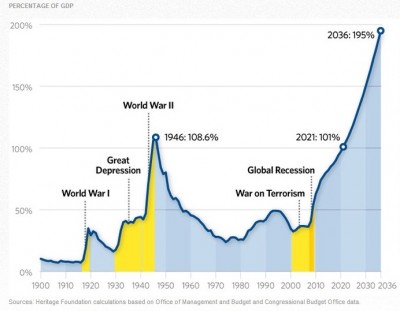The government shutdown actually helped increase the national debt, as it jumped a record $328 billion the day after the shutdown ended and passed $17 trillion.
The reason for the big day of borrowing was that the Treasury Department was shut down for two weeks and unable to issue treasury bonds because of the battle on Capitol Hill. To make up for the two weeks without bonds, the department had to issue two weeks’ worth of debt at once.
How big is the debt? If you stacked $17 trillion in $1 bills, it would stretch to the moon and back – twice.
A threat to national security
Countries worldwide are taking note of America’s debt.
“The problem (in America) is an absolutely unsustainable level of indebtedness,” Liam Fox, the former British defense minister, told the Heritage Foundation. “The problem is in the western economies which are up to their necks in debt and if we don’t do something about it we’ll drown in that debt.”
New book reveals how to keep this “gangster” economy from murdering your money…
The $17 trillion US national debt is actually larger than the Gross Domestic Product (GDP) — the amount of goods and services America produces every year. In 2012 the US GDP was $15.68 trillion.
Fox noted that all the major Western countries, including Britain, have unsustainable levels of debt. He pointed out that Britain now spends more on debt repayment than on its military and foreign aid budgets combined. Fox believes that the same thing will soon happen in America.
Admiral Mike Mullen, the former chairman of the Joint Chiefs of Staff, said America’s debt is “the single biggest threat to our national security.” Mullen told Forbes he believes that the national debt will diminish America’s international standing and influence.
How the national debt could hurt your family
The national debt is out of control and a threat to the future of every American. Here are a few facts about the national debt, and the menace it poses composed by Off the Grid News and the Heritage Foundation:
- The average American’s share of the national debt is now $53,769.
- Over at decade, the national debt will drag the economy and lower the income of the average family by $11,000. That’s because high-debt economies grow slower than low-debt economies.
- The debt will slow the growth of the economy because those families will be buying fewer goods and services. That will mean fewer jobs and lower salaries for those who can find work.
- Economic growth could stall. The Heritage Foundation noted that nations with a debt to GDP ratio of 120 percent had an economic growth rate of only 1.2 percent. Countries with a ratio of 90 percent grew by 2.3 percent. America’s debt to GDP ratio is now 115 percent and it is growing fast.
- Increasing the debt level raises the cost of borrowing money. This could lead to higher interest rates on business loans, car loans and mortgages and put those instruments out of some people’s reach.
- Increasing levels of debt could make US treasury bonds worth less and lower the interest rates on them. That could decrease retirement income because many pension funds are heavily invested in treasury bonds.
- The huge debt could make money worth less and increase inflation. It could also erode confidence in the US dollar which also increases inflation. That means less buying power for families because salaries and savings will be worth less.
- At some point the government might not be able to make Social Security, Medicare, Medicaid and other benefits payments because of the debt. If that happens, those who depend on such programs could be left without money or health care.
Americans need to pay attention and start taking steps to protect their families’ economic future, Liam Fox said.
“The American people are being overtaxed so the government can over borrow,” Fox said.
 Off The Grid News Better Ideas For Off The Grid Living
Off The Grid News Better Ideas For Off The Grid Living





